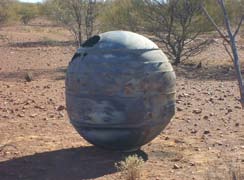[/caption]
This just in from ‘The Sky is Falling’ Department: NASA’s Orbital Debris Newsletter reports that a launch vehicle rocket motor casing was found by ranchers in the Australian Outback during a cattle round-up on a three million-acre pasture property. It was first spotted by Mr. Arthur Taylor who was flying a Cessna aircraft to look for stray cattle. The casing appeared in relatively good condition (see picture above) and did not seem to be very old. Mr. Michael White forwarded numerous photos of the object to the NASA Orbital Debris Program Office, including one with a clear serial number next to the nozzle attachment point. Using the serial number, NASA Kennedy Space Center personnel were able to trace the motor casing to a a specific mission.
The casing came from a Delta 2 rocket used on June 2, 1990 to launch the Indian INSAT-1D geosynchronous spacecraft from the Cape Canaveral Air Force Station, Florida. This solid rocket motor served as the launch vehicle’s third stage which carried the payload from a low altitude parking orbit into a geosynchronous transfer orbit. (If you want to trace it yourself, here are the particulars: U.S. Satellite Number 20645, International Designator 1990-051C), Reentry of the stage occurred a few months later.
This isn’t the first time rocket casings have been found in Australia, and this object joins similar solid rocket motor casings found in Saudi Arabia, Thailand, and Argentina during the past several years.
Yikes!
Sources: CollectSpace, NASA’s Orbital Debris Program


Well, at least it’s not making a mess up there then.
Not “yikes!”: “crikey!”
(I think)
Still, the number of these things that has been found here and there is perhaps a good indication that they may need to be given a different shape to make them actually burn up instead of just falling. This one looks almost pristine and that can’t be good. Someday, some unlucky bystander will be hit by one of those.
Some really unlucky bystander. The odds are really low. But if we add the odds of property damage, they rise quite a bit. That’s also not good.
Is there insurance against such a thing?
I am really surprised that NASA doesn’t keep track of fallin debris better.
We’re used to it mate, crikey, we’ve had dozens of bits hit us instead of the pacific .. had bloody skylab too ! Thankfully no kangaroos were hit or the sheilas would have had nothing but vegemite to eat for a week .. 😉
We’ve all got 3 Million acre propertys down here .. but not too many of them are ‘pasture properties’, more likely saltbush barren tracks of sand !!
I’d love to have been there when it came down – “What the ^%$^ was that?!?”
This is actually a Star(c) 48B motor, the third stage of the Delta rocket.
http://www.spaceref.com/news/viewpr.html?pid=4903
I remember as a kid being driven by my parents along the Gunbarrel hwy through Western Australia and the road houses along the way had collected space junk that had fallen earthward. What struck me (so to speak) was the size of some of the junk. Many items were the size of a domestic fridge, imagine that falling on you!
It was designed and expected not to disintegrate while operational. And so it kept in shape while it did hasten all the way back into the gravitational sink hole.